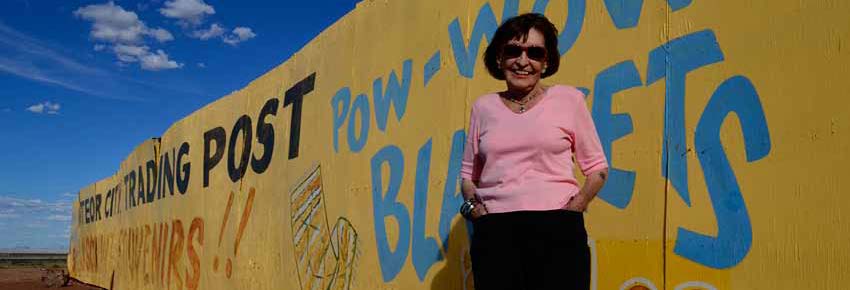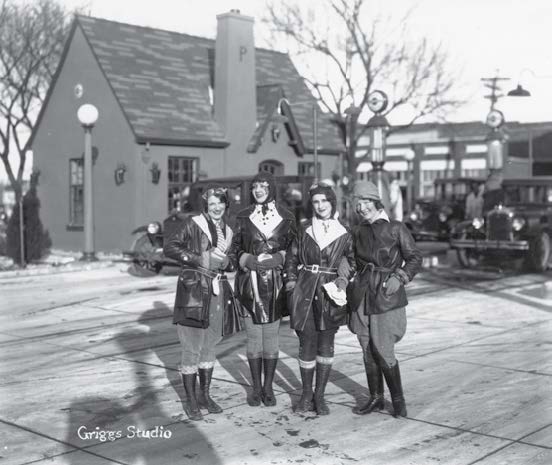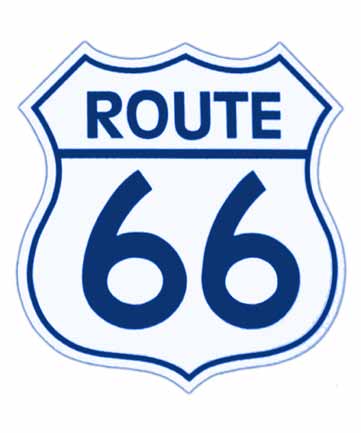A new public history project, The Women on the Mother Road: Route 66, sheds light on women’s experiences along the historic highway.
We tend to view Route 66 romantically, as a path for great adventure according to Heidi Osselaer, faculty associate in the History Department at Arizona State University. “While that is an important facet of the Mother Road, it was also an escape route for many people fleeing poverty during the Great Depression as well as a lifeline for many families living in small towns along its path struggling to make ends meet,” says Osselaer.

Jane Dippel at Meteor City
The period covered by Route 66’s history from its inception in 1926 to its decommissioning in 1985 and ongoing revitalization represents an evolution of women’s lives. The research and stories gathered along the highway fit into a wider context of women’s history in America.
“As a mirror-reflection of the socioeconomic climate of its time, Route 66 can tell many important stories of America through decades of significant change in the 20th century,” says Kaisa Barthuli, program manager of the National Park Service Route 66 Corridor Preservation Program. “This proj- ect helps shed light on some of the under-told stories, reveal- ing a deeper understanding of the important role of women in this chapter of American history.”
Writer and project director Katrina Parks traveled Route 66 to collect dozens of oral histories that tell unique stories of the road, including these examples.

The Santa Fe Indian Band started off informally as a recreational activity for Santa Fe railroad employees in 1923 and evolved into an all-Indian band. The band had members from seven tribes, including Rosemary Natseway’s father, Lefty Siow. In seventh grade, Rosemary auditioned for the band and became the second clarinet chair. The group performed at many events along Route 66, which runs parallel to the railroad in the Southwest.
The Blue Swallow Motel has been an icon on the Mother Road since 1940, and its most famous proprietor, Lillian Redman, assumed management in the 1950s. She was renowned for her kindness, accepting trade or providing rooms for free to customers in need, and also for her feisty personality. As Lillian said, “I end up traveling the highway in my heart with whoever stops here for the night.” She sold the hotel in the late 1990s and passed away soon after.
For two decades, Jane Dippel has made an annual trip on Route 66 documenting her adventures along the Mother Road. Dippel traces her love of the road back to the late 1940s when she and her siblings would walk over to Marty’s Market in St. Louis on Route 66. “We bought watermelon from a cooler out front and sat in the parking lot watching the travel- ers coming in and out, and checking out their license plates,” she recalls.

The Phillips 66 Highway Hostesses were registered nurses who were recruited in 1939 to inspect that the brand’s gas stations were hospital clean. Phillips’ goal was to target female customers who would opt for the cleanest bathroom and lead their husband and family in that direction.
“Wives and mothers often worked in unglamorous jobs in restaurants and hotels, even in the war industries during World War II,” adds Osselaer. “The stories of the women who lived and worked along Route 66 are the stories of average Americans struggling to survive during hard times. The National Park Service is to be congratulated for its important role funding the preservation of this history.” For more information, see www.route66women.com.
Did you enjoy this article? Join the SCA and get full access to all the content on this site. This article originally appeared in the SCA Road Notes, Winter 2016, Vol. 24, No. 4. The SCA Journal is a semi-annual publication and a member benefit of the Society for Commercial Archeology.
More Articles Join the SCA


